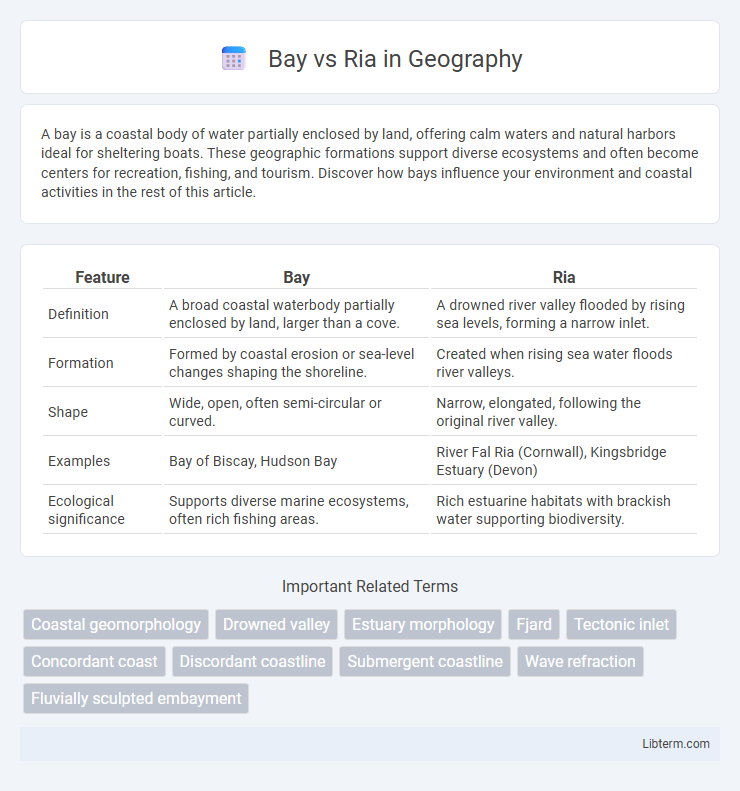A bay is a coastal body of water partially enclosed by land, offering calm waters and natural harbors ideal for sheltering boats. These geographic formations support diverse ecosystems and often become centers for recreation, fishing, and tourism. Discover how bays influence your environment and coastal activities in the rest of this article.
Table of Comparison
| Feature | Bay | Ria |
|---|---|---|
| Definition | A broad coastal waterbody partially enclosed by land, larger than a cove. | A drowned river valley flooded by rising sea levels, forming a narrow inlet. |
| Formation | Formed by coastal erosion or sea-level changes shaping the shoreline. | Created when rising sea water floods river valleys. |
| Shape | Wide, open, often semi-circular or curved. | Narrow, elongated, following the original river valley. |
| Examples | Bay of Biscay, Hudson Bay | River Fal Ria (Cornwall), Kingsbridge Estuary (Devon) |
| Ecological significance | Supports diverse marine ecosystems, often rich fishing areas. | Rich estuarine habitats with brackish water supporting biodiversity. |
Introduction to Bays and Rias
Bays are broad coastal indentations where the sea encroaches into the land, often characterized by gentle slopes and sheltered waters, facilitating harbors and marine activities. Rias are submerged river valleys formed by rising sea levels, featuring narrow, elongated inlets that extend inland with steep sides and deep waters. Both bays and rias significantly influence coastal geography and ecosystems, affecting navigation, sediment deposition, and biodiversity.
Defining Bays: Key Features and Formation
Bays are coastal bodies of water partially enclosed by land, characterized by a wide opening to the sea that allows tidal flow and marine exchange. Formed primarily through processes such as erosion, tectonic activity, and sediment deposition, bays often develop where softer rock erodes faster than surrounding harder rock, creating recessed shorelines. Key features of bays include calmer waters ideal for harbors, diverse ecosystems, and the potential for significant sediment accumulation impacting coastal dynamics.
Understanding Rias: Origins and Characteristics
Rias are coastal inlets formed by the partial submergence of river valleys, resulting from rising sea levels or land subsidence, creating estuary-like environments with branched channels. These geological features typically exhibit a dendritic pattern, often deeper and narrower than bays, and serve as important habitats for diverse marine and bird species. Understanding rias involves recognizing their role in coastal ecosystems, sediment deposition, and as natural harbors influencing human settlement and navigation.
Geological Processes Behind Bays and Rias
Bays form primarily through coastal erosion where softer rock is worn away by wave action, creating a wide, open inlet with gentle slopes. Rias develop from the drowning of river valleys caused by rising sea levels, resulting in narrow, branching inlets with steep sides that reflect former riverbeds. Both features are shaped by sea level changes and tectonic activity, but bays tend to be broader and more open, while rias maintain the intricate contours of submerged river systems.
Differences Between Bays and Rias
Bays are broad coastal indentations often formed by tectonic activity or erosion, characterized by their wide and shallow shapes, whereas rias are drowned river valleys created by rising sea levels flooding river valleys, resulting in narrow and elongated inlets. Bays generally have a more open connection to the ocean, allowing for expansive water exchange, whereas rias tend to have a more confined entrance, leading to unique tidal patterns and sediment deposition. The geological origin and morphology differences influence the ecosystems and navigation conditions specific to bays and rias.
Ecological Significance of Bays vs Rias
Bays serve as crucial habitats for diverse marine and coastal species, providing shelter, breeding grounds, and nutrient-rich waters that support complex ecosystems. Rias, formed by submerged river valleys, create unique estuarine environments with varying salinity gradients that foster high biodiversity and serve as important nurseries for fish and bird populations. Both bays and rias significantly contribute to coastal ecological productivity but differ in geomorphological features that influence their specific habitat types and species assemblages.
Economic and Cultural Importance
Bay and Ria both hold significant economic and cultural importance, serving as vital centers for maritime trade, fisheries, and tourism. Bays typically provide natural harbors that support large ports and urban development, driving regional economies through shipping and commerce. Rias, with their distinctive drowned river valleys, offer rich biodiversity and attract tourism due to their scenic beauty and cultural heritage sites, promoting local economies and preserving historical maritime traditions.
Famous Examples of Bays Around the World
The Chesapeake Bay in the United States, known for its extensive estuarine system, supports diverse ecosystems and a booming seafood industry. The Bay of Bengal, the world's largest bay, plays a crucial role in regional climate and economic activities across South Asia. San Francisco Bay in California is renowned for its iconic Golden Gate Bridge and serves as a major hub for maritime trade and urban development.
Notable Rias and Their Locations
Notable rias include the San Francisco Bay in California, characterized by its deep natural harbor and extensive estuarine ecosystem. The Oslofjord in Norway is a prominent ria known for its fjord-like appearance and significant maritime activity. Other famous rias such as the Kenai Peninsula coast in Alaska and Galicia in Spain offer unique ecological habitats and are important centers for fishing industries.
Conclusion: Comparing Bays and Rias
Bays and rias both represent coastal water bodies formed by the interaction of land and sea, yet they differ markedly in origin and morphology; bays are broad, curved indentations typically formed by erosion or tectonic activity, while rias are drowned river valleys created by rising sea levels. Ecologically, rias often support richer biodiversity and serve as important estuarine habitats due to their freshwater influx and sheltered waters, whereas bays provide extensive shoreline habitats and are crucial for commercial ports. Understanding these differences is vital for coastal management and conservation strategies tailored to each distinct environment.
Bay Infographic

 libterm.com
libterm.com